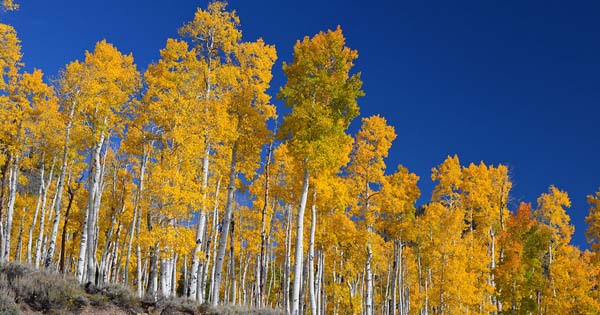No Wonder It Quakes
A massive aspen grove with a single root system might be immortal, or might be heading for extinction

In one section of the Fishlake National Forest in Utah, the quaking aspens seem to take a little more space for themselves. The distance between white trunks lengthens, and the sunlight has a chance at all the leaves, which are the color of artichokes in the summer and amber in the fall. These leaves tremble furiously even in a slight breeze, such that from a distance, the forest gives the strong impression of having a case of the shivers.
This roomy stretch—thousands of trees, roughly 13 million pounds of biomass—is actually one living organism, a single rhizome that has been replicating and replicating, sending up new tree shoots as others die, for millennia. The exact age is unknown, but it’s estimated to be between 80,000 and a million years. This means that, conservatively, the tree has been alive since humans began to use tools, and possibly since we discovered fire. In this time, it has grown to be the largest known living organism, and for its Methuselah-like achievements it has earned itself a name: Pando, which is Latin for “I spread.” Pando is beautiful, male, gigantic, theoretically immortal, and possibly dying.
What does it mean to be theoretically immortal? Michael Grant, one of the scientists who brought Pando to public attention in 1993, explains that Populus tremuloides reproduce both sexually, through seeds and flowers, and asexually—by sending out new root suckers underground. This dual method of reproduction is the key to quaking aspens’ remarkable ubiquity—the species is the most widely distributed tree in North America—and longevity. “There’s a lot of biology that doesn’t age and die,” says Grant, “but we don’t always know why.”
Pando’s individual trees are born, age, and die, but the clone itself, the organism united by a single genetic code and a massive root structure, persists. When trees are killed off by fire or storm, energy transfers through the roots and stimulates growth elsewhere. Pando’s size makes it resistant to wipeout by a single natural disaster, so its cyclic growth could carry on forever. Karen Mock, a geneticist leading research on Pando, suspects that none of its original tissue remains. “The intangible is more persistent than the individual embodiments of it over time,” she wrote to me.
A friend once declared that aspens “share their roots,” reaching out and clasping together as if holding hands. I insisted that aspens don’t hold hands; they are the same tree, a triumphant single organism. I saw the individual, and he saw the collective—which, he observed dryly, might be some kind of metaphor. Organisms such as Pando challenge distinctions like individual versus collective. They suggest that our most common assumptions about individuality are limited and perhaps limiting. Like Pando, the human body regenerates and replaces itself over time. Our bodies experience total cellular turnover roughly every seven years, which means that the cells that constituted us at birth are gone and gone and gone again—but we are here. Still, hiking through Pando, one sees many trees, clustered together but distinct, just as when walking in a crowded city one sees the swarm but feels even more intensely one’s own singular movement through it, the individual body as alike but separate from other bodies.
In her latest book, On Immunity, Eula Biss points out that the perception that we are physically discrete—closed systems protected by a boundary of skin—infects our metaphors as much as it informs our social and medical decisions. This idea is inherently flawed. Bodies are permeable, and their survival doesn’t simply rest on the individual immune system but depends on a larger system of herd immunity, the reliance of our health on the health of those around us. “Our bodies may belong to us, but we ourselves belong to a greater body composed of many bodies,” Biss writes. “We are, bodily, both independent and dependent.”
Pando, though immortal in theory, appears to be in danger of dying. The reasons for this are imperfectly understood, but among them may be severe droughts, land development, a surge of insects, and mammals that have eaten the tender young tree shoots. Fire prevention efforts have, counterintuitively, suppressed the periodic burns crucial to the stand’s life cycle. In this respect, Pando is one high-profile victim of “sudden aspen decline,” the mass die-off of quaking aspen all over North America that scientists have been tracking since roughly 2004. Pando’s older trees remain, but the young ones aren’t flourishing, and the average age of trees in the stand is rising quickly. The clone is facing a struggle we recognize: it is aging.
In Utah, Karen Mock’s team is fencing off Pando’s new growth to protect it from browsing animals and is working to understand the sudden decline. If drought and rising temperatures are the true culprits, little can likely be done. It would be unsettling to watch Pando die. The death might have the tragic flavor of extinction—not just because sudden aspen decline raises the threat of the demise of North America’s most prevalent tree, but because the death of this single clone will mean, my friend would point out, the death of many interconnected individuals. As is typical for quaking aspens, every tree in the clone is an exact copy of the one next to it—the same leaf patterns, the same black scarring on the trunks. In a small corner of Utah, it has been possible, nearly forever, to get lost in a hundred acres of this one particular pattern, making itself new again and again. We carry on in similar fashion, playing with fire and holding hands with ourselves.

